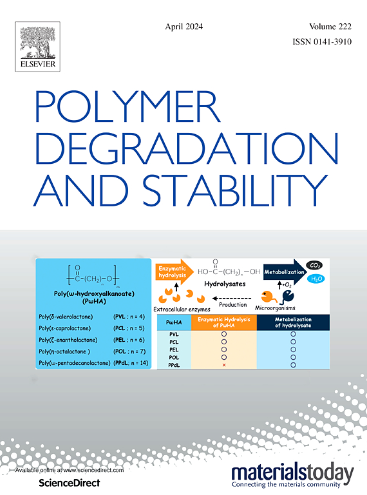Phosphorus- and metal-free flame-retardant strategy based on π-π stacking enables flexible polyurethane sponge with high compression resistance and oil-water separation properties
IF 7.4
2区 化学
Q1 POLYMER SCIENCE
引用次数: 0
Abstract
The development of adsorbent materials capable of withstanding harsh environmental conditions remains a significant challenge. In this study, a novel flexible polyurethane (FPU) sponge composite (PU@BTC-Abz@Si) was successfully fabricated with outstanding flame retardancy, mechanical robustness, and oil-water separation performance. This was achieved by constructing micro-nano structures on the surface of FPU sponge by in situ self-assembly of dendrimers with π-π stacking interactions, and subsequent grafting with polydimethylsiloxane (PDMS). Notably, the synthesis was accomplished without the incorporation of phosphorus or metal-based flame retardants. Instead, PU@BTC-Abz@Si utilizes a flame-retardant strategy based on π-π stacking, imparting fire safety while minimizing secondary environmental pollution. Compared with pristine FPU sponge, PU@BTC-Abz@Si demonstrated significant reductions in total heat release (THR), total smoke production (TSP), and total carbon monoxide production (TCOP) by 55.4%, 51.9%, and 64.9%, respectively. Furthermore, PU@BTC-Abz@Si exhibited enhanced mechanical stability and high oil-water selectivity. This work offers a sustainable and efficient approach to enhance the functional performance of FPU sponge, with promising implications for environmental protection and fire-safe engineering applications.
基于π-π堆积的无磷无金属阻燃策略使柔性聚氨酯海绵具有高抗压性和油水分离性能
开发能够承受恶劣环境条件的吸附材料仍然是一个重大挑战。在本研究中,成功制备了一种新型柔性聚氨酯(FPU)海绵复合材料(PU@BTC-Abz@Si),该材料具有优异的阻燃性、机械坚固性和油水分离性能。这是通过在FPU海绵表面原位自组装具有π-π堆叠相互作用的树状大分子,并随后与聚二甲基硅氧烷(PDMS)接枝来构建微纳结构来实现的。值得注意的是,合成完成时没有磷或金属基阻燃剂的掺入。相反,PU@BTC-Abz@Si采用基于π-π堆叠的阻燃策略,提高消防安全,同时最大限度地减少二次环境污染。与原始FPU海绵相比,PU@BTC-Abz@Si的总放热(THR)、总产烟(TSP)和总一氧化碳(TCOP)分别显著降低了55.4%、51.9%和64.9%。此外,PU@BTC-Abz@Si表现出增强的机械稳定性和高油水选择性。本研究为提高FPU海绵的功能性能提供了一种可持续和有效的方法,在环境保护和消防安全工程应用方面具有广阔的应用前景。
本文章由计算机程序翻译,如有差异,请以英文原文为准。
求助全文
约1分钟内获得全文
求助全文
来源期刊

Polymer Degradation and Stability
化学-高分子科学
CiteScore
10.10
自引率
10.20%
发文量
325
审稿时长
23 days
期刊介绍:
Polymer Degradation and Stability deals with the degradation reactions and their control which are a major preoccupation of practitioners of the many and diverse aspects of modern polymer technology.
Deteriorative reactions occur during processing, when polymers are subjected to heat, oxygen and mechanical stress, and during the useful life of the materials when oxygen and sunlight are the most important degradative agencies. In more specialised applications, degradation may be induced by high energy radiation, ozone, atmospheric pollutants, mechanical stress, biological action, hydrolysis and many other influences. The mechanisms of these reactions and stabilisation processes must be understood if the technology and application of polymers are to continue to advance. The reporting of investigations of this kind is therefore a major function of this journal.
However there are also new developments in polymer technology in which degradation processes find positive applications. For example, photodegradable plastics are now available, the recycling of polymeric products will become increasingly important, degradation and combustion studies are involved in the definition of the fire hazards which are associated with polymeric materials and the microelectronics industry is vitally dependent upon polymer degradation in the manufacture of its circuitry. Polymer properties may also be improved by processes like curing and grafting, the chemistry of which can be closely related to that which causes physical deterioration in other circumstances.
 求助内容:
求助内容: 应助结果提醒方式:
应助结果提醒方式:


